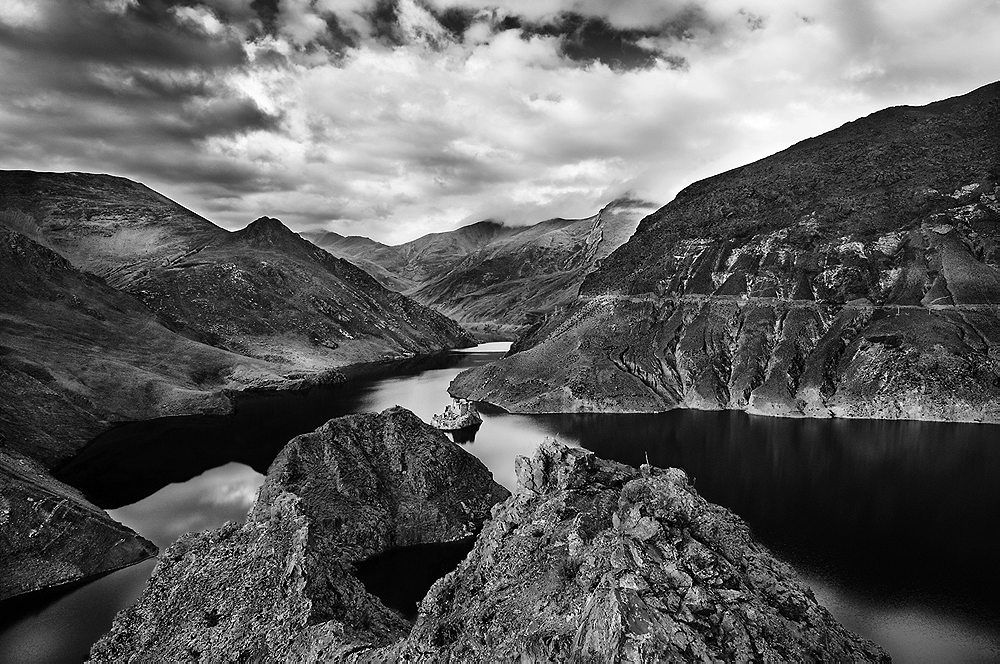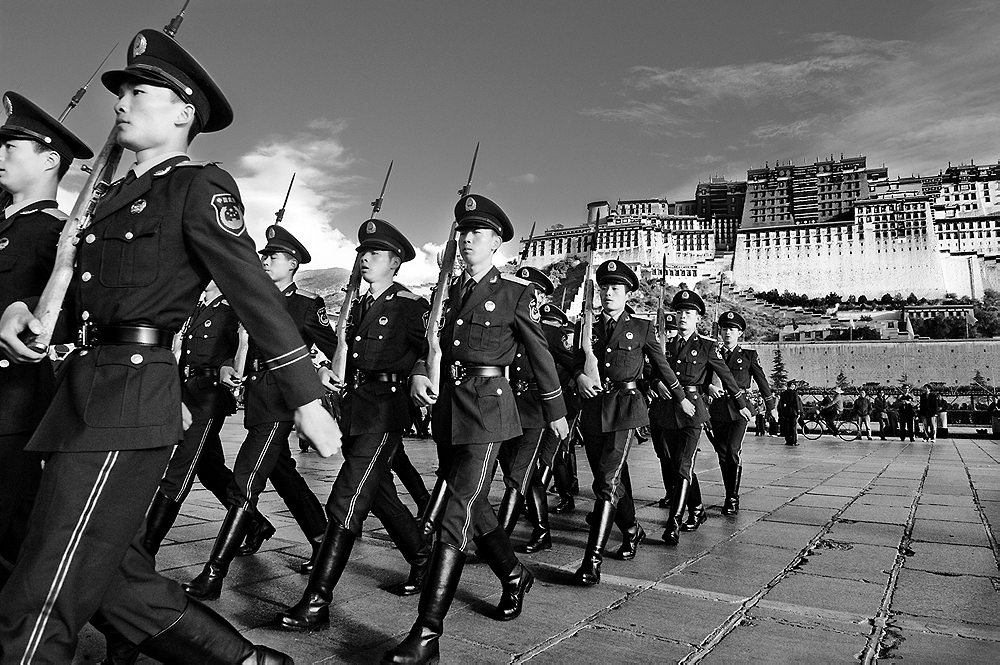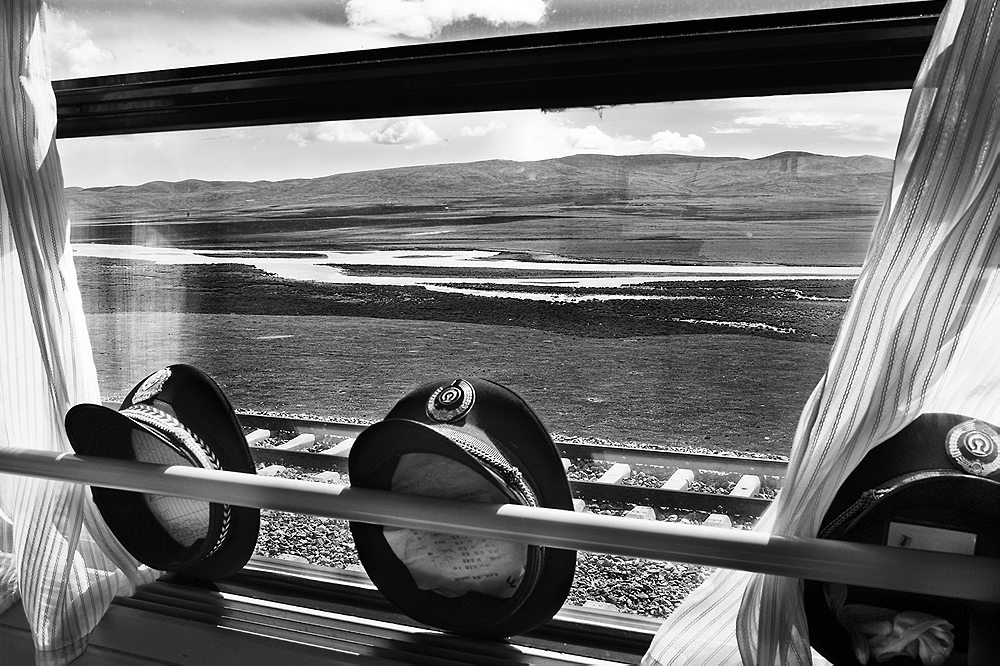Photographer Laurent Zylberman’s stunning book on the complexities of Tibet is coming out in English.
Laurent Zylberman was among the first Westerners authorized to enter Tibet after the deadly riots of March 2008. What he found there was a far more complex story that he expected. He met the separatists and those who want to integrate, businessmen and monks, newcomers and the traditionalists. With a stark black-and-white palette, his photographs tell all those stories against stunning background of nature. But after fifteen days in the region accompanied by journalist Eric Meyer, he went home to find his editors, confused by his editorial line, had pulled out funding for a book project. Both men decided to take on financing themselves through exhibitions and crowdsourcing, and managed to raise enough to publish Tibet, The Last Cry, a journal of 40 photographs with text. It’s already been published in Spanish and French, and an English edition is on its way.
Roads & Kingdoms: What’s your reason for publishing in three languages?
Laurent Zylberman: Our stance is that the situation in Tibet is a fixation for many foreigners who know little about it. It’s always been portrayed as a black and white situation, someplace where there is no middle road. The usual point of view is “bad red Han Chinese” versus “cool yellow hat monks.” So we wanted to reach far and wide, adding German and Italian editions, but it’s been tough.
R&K: What were the challenges you faced?
LZ: Editors didn’t agree with our line. As any country that has been invaded and colonized, the incoming influx of people, customs, laws and military power in Tibet is brutal. But there are people keen to maintain some kind of autonomy. These people are hardly heard. Hardliners exist too on the Tibetan side. Many resent the suppression of their culture and the disappearance of former walks of life, mostly the nomadic habits. We met people on both sides, eager to find a common ground and talk to each other, but they can’t really voice their opinions out loud.
This is what I show: control. Everywhere. All the time. But in a subtle way.
R&K: Why do you think editors were uncomfortable with that story?
LZ: Editors want to see more guns and the army beating up monks. Or, they want a nice coffee table book with colorful pictures. Somehow our balanced view was not radical enough for them. That’s why we resorted to a crowd-funding scheme to finance the books.
R&K: It must have been very frustrating…
LZ: Yes, we had this very rare official permission to work in Tibet because authorities knew who we were after we both spent a number of years in China. So we had a deal with a big editor before our departure. While on the go, I posted photos and Eric sent some texts relating the trip. They dumped us saying that this was not what they expected, and that they wanted nice touristic stuff. Others wanted something more gloomy and could not take the fact that some Han Chinese we were talking to had views similar to the Tibetans.


R&K: Is that what you expected to find in Tibet?
LZ: I didn’t expect much difference from other areas of China populated by minorities that I had previously visited—a massive input of manpower, government and control, and the loss of local identities. While there, I was surprised to see how much money is poured in this land as well as the large influx of laymen who are eager to catch a slice of the pie.
R&K: How did you get this official permission and did you feel the pressure of censorship by local authorities?
LZ: I flew to Beijing on a Saturday after a long, harrowing quest—20 years!—to get that visa. The train to Lhasa was departing that evening, we had the tickets, but not the document allowing us to buy them. Around 4pm a man from the Interior Ministry rang Eric’s doorbell and delivered it. We rushed to the station. It was me, Eric, Brigitte (logistics) and a Chinese man who was our translator and fixer.
R&K: It took you 20 years to get the visa?
LZ: Yes, I applied first in 1987. I tried to travel there on two occasions, which were both denied. We did not want to work undercover, sneaking in as tourists. And actually, the Tibetan authorities were not really keen on having us either. We were watched over 24/7. We had a representative from the local government with us all the time except at the hotel. She would arrange our schedules and report to her boss constantly. The driver was on her side, so he wouldn’t always stop when we wanted. She controlled who we talked to and reported when those contacts where not on her list. When we strayed away, changing drivers without warning, we received a call from Beijing 15 mins after our arrival, even though we even had switched our phones off. And when I skyped abroad, I could hear voices on the line.
R&K: How did that make you feel? Did that become part of the story?
LZ: We were more than safe. Nothing could happen to us, because that would have been proof that someone had made a mistake in allowing us in the country. They used us as part of propaganda, and on many photos, this is what I show: control. Everywhere. All the time. But in a subtle way. So of course this control and how we could show it IS the story.


R&K: Fifteen days is quite a short amount of time, where did you go and who did you meet?
LZ: We didn’t travel as far as we wanted. Lhasa of course was a base and we would go back and forth. We drove to Shigatze and around Namtso Lake. One important character was our young guide, a Tibetan student working for the local government and torn apart between her ancestral culture and the new order descending over Tibet. She enjoyed a comfortable life and a secure job, but money is not the issue for most Tibetans, while it’s high on the Chinese list of priorities. So she understood very well our problem and requests but had a job to keep. Another character was a guy on the train to Lhasa. Very proud of his commercial successes, he had an utmost arrogance and couldn’t have cared less about what the Tibetans think. One day, in a garden tea house, we talked to two young art students and they introduced us to some more radical guys. One of them invited us to her dance school, which was okayed by the authorities. But once there, we could not talk to this student anymore, only hear the nice talk from her teachers and principal. She was there, listening and looking down, we knew she had been “corrected.”
R&K: It’s been five years since that trip. Looking back, do you think the situation has improved?
LZ: No. The few people who can voice something within Tibet are silenced. Five years is a long time, but to me it feels like yesterday. Very few stories have left such a deep impact on me. A feeling that in Tibet lay a solution to many other issues in the world. Tibetans have developed a unique life balancing inner and outer development of manhood, and that is being destroyed. I’m not religious or anti-system or conservationist, but I found such a peace of mind while visiting Tibet – despite the turmoil. It’s something more like a personal certitude than a journalistic observation.
You can pre-order Tibet, The Last Cry here